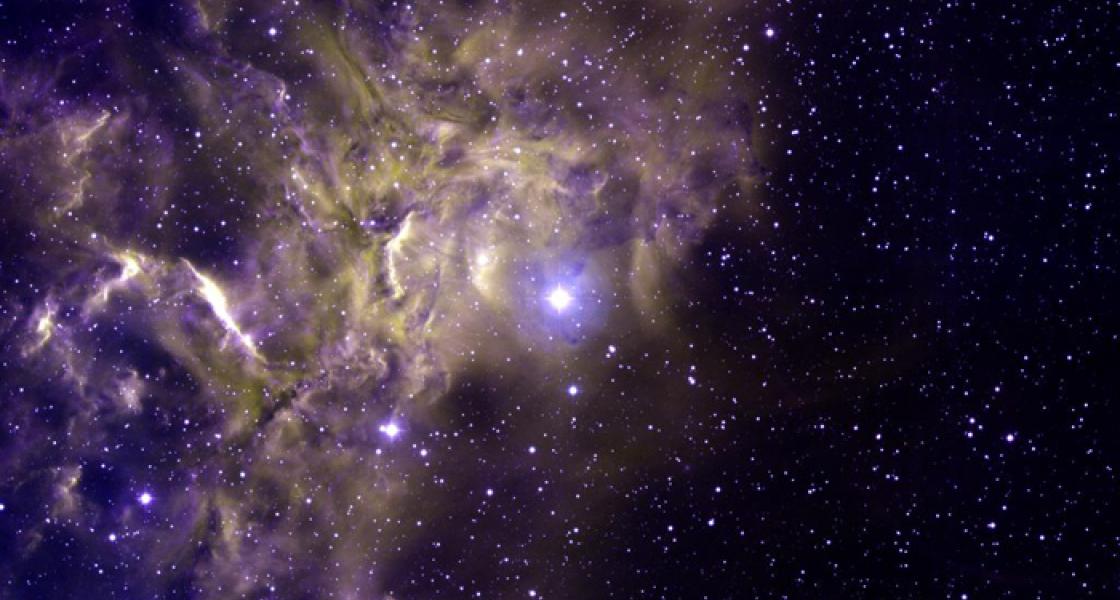Left to their own devices, deuterium atoms would attach themselves to cold specks of soot floating in interstellar gas clouds and remain there for eternity. In fact, deuterium has a great affinity for the buckyballs, bucky onions, bucky tubes, and other forms of carbon, such as polycyclic aromatic hydrocarbons, comprising soot. It readily replaces hydrogen in these molecules. Deuterium atoms bond to interstellar soot so tightly it takes an encounter with a hot star or supernova explosion to pry them loose.
Bucky balls, tubes, and onions belong to a class of molecules known as fullerenes. A bucky ball not only resembles a soccer ball, but also one of the geodesic domes popularized in the 1960s by its namesake, Buckminster Fuller. Bucky onions consist of nested bucky balls (just like the Russian dolls), and bucky tubes are cylindrical fullerenes. Carbon-rich fullerenes, it turns out, are abundant in interstellar gas clouds. The smoky-looking material in the photograph at right is mostly interstellar carbon-rich dust grains, or soot.
Deuterium's soot-bonding proclivities are big news in the world of astronomy. Two years ago, Fellow Jeff Linsky and Research Associate Brian Wood announced at an American Astronomical Society meeting in Denver that they'd solved a major galactic mystery: how to measure the total abundance of deuterium in our galaxy. To do so, they had to figure out why the deuterium concentrations in nearby interstellar gas vary depending on where you look. The researchers proposed that in quiet regions of the galaxy, deuterium is happily bonded to soot and can't be seen (or measured). In active regions with hot stars or a recent supernova, deuterium is relatively abundant in the gas, having been forcibly expelled from soot.
The researchers found that the ratio of total deuterium to total hydrogen in the local galactic disk is at least 23 parts per million. Astronomers believe the ratio was about 27 parts per million when deuterium was created during the Big Bang 14 billion years ago. You wouldn't think this finding, or the new theory behind it, would be particularly controversial, especially since there is no good competing model. It even allows for the disappearance of some the universe's original deuterium supply via nuclear reactions in stars, which convert deuterium to helium and heavier elements.
Even so, it took more than a year and a half for a paper describing these findings to be accepted for publication. In the meantime, Italian astrophysicist Donatella Romano and her colleagues have evaluated the new theory in the context of the standard model of galactic chemical evolution. The model's goal is to explain the abundance of all 92 natural chemical elements in our galaxy and throughout the universe. They conclude that Linsky and Wood's explanation of the depletion of deuterium due to soot bonding is the most likely mechanism proposed thus far to explain the observed patterns of deuterium concentration in our galaxy.
The work described here appeared in the August 20, 2006, issue of The Astrophysical Journal. - Julie Phillips



 The Physics Frontiers Centers (PFC) program supports university-based centers and institutes where the collective efforts of a larger group of individuals can enable transformational advances in the most promising research areas. The program is designed to foster major breakthroughs at the intellectual frontiers of physics by providing needed resources such as combinations of talents, skills, disciplines, and/or specialized infrastructure, not usually available to individual investigators or small groups, in an environment in which the collective efforts of the larger group can be shown to be seminal to promoting significant progress in the science and the education of students. PFCs also include creative, substantive activities aimed at enhancing education, broadening participation of traditionally underrepresented groups, and outreach to the scientific community and general public.
The Physics Frontiers Centers (PFC) program supports university-based centers and institutes where the collective efforts of a larger group of individuals can enable transformational advances in the most promising research areas. The program is designed to foster major breakthroughs at the intellectual frontiers of physics by providing needed resources such as combinations of talents, skills, disciplines, and/or specialized infrastructure, not usually available to individual investigators or small groups, in an environment in which the collective efforts of the larger group can be shown to be seminal to promoting significant progress in the science and the education of students. PFCs also include creative, substantive activities aimed at enhancing education, broadening participation of traditionally underrepresented groups, and outreach to the scientific community and general public.